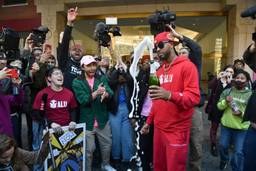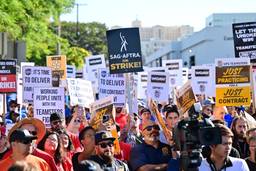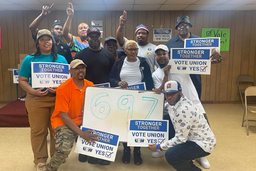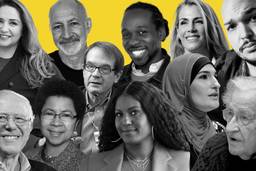A Brief History of the U.S. Government’s Targeting of Left-Wing Immigrants
Throughout U.S. history, right-wing forces have used the denial of citizenship to restrict political dissent.
Shaun Richman
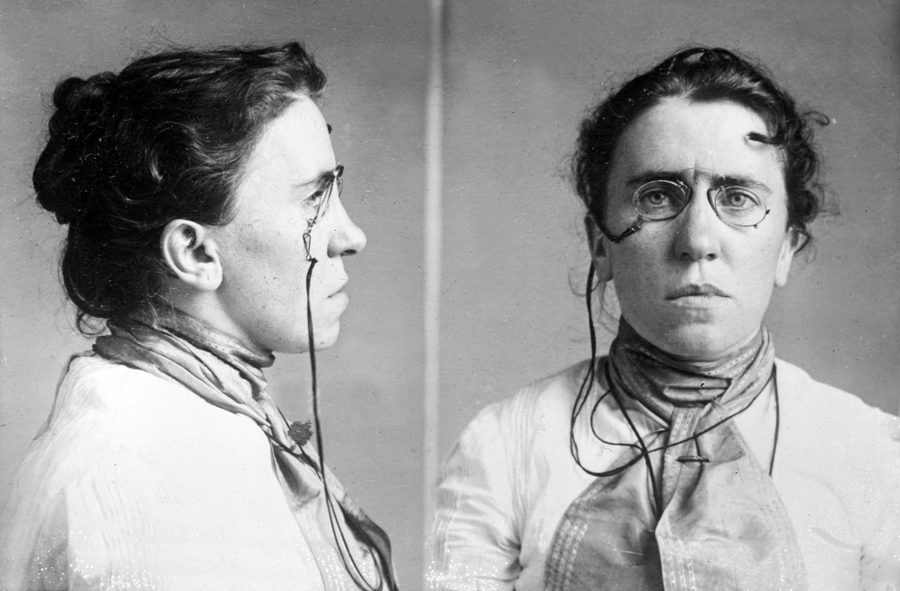
On September 8, 1947, federal agents walked into the midtown Manhattan office of the Hotel, Restaurant & Club Employees & Bartenders Union Local 6 and arrested its president for being an “undesirable alien.” Michael J. Obermeier had been organizing hotel workers into a succession of scrappy independent unions since he arrived in New York as a German immigrant around the time of the first World War. By the time of his arrest, he led 27,000 union members in a powerful affiliate of the American Federation of Labor.
That same day, attorneys for the CIO’s Transport Workers Union Local 100 were fighting an aggressive move to deport John Santo, the union’s Romanian-born organizing director. Local press asked the Deputy Commissioner of Immigration and Naturalization, Thomas Shoemaker, if these actions were a part of a crackdown. Shoemaker’s mild response was that the legal actions were “in the normal order of business.”
The truth is that they were both. The federal government was cracking down on union leaders it believed to be Communists, and it was specifically targeting activists based upon their immigration status. Dozens of arrests, prosecutions and deportation procedures were initiated against alleged Communist activists in the weeks and months that followed. It’s a pattern that has marked American politics for over a century.
A new book by lawyer and historian Julia Rose Kraut, Threat of Dissent: A History of Ideological Exclusion and Deportation in the United States, comprehensively lays out this long history of using the denial — and even the threatened removal — of citizenship in order to restrict some forms of political action.
A history of ideological exclusion
Restrictions on naturalization coincided with the advent of partisan politics, according to Kraut. Article I of the Constitution directs Congress to “establish an uniform rule of Nationalization,” and the first one that Congress set, in 1790, allowed white foreigners to become citizens after just two years of residency. This liberal policy made the United States a haven for political refugees throughout the 1790s, and they became active in American politics. The Irish fleeing British rule and French fleeing the twists and turns of their revolution tended to support Thomas Jefferson’s new Democratic-Republican clubs that were critical of the Federalists’ drive for a strong central government.
By the end of the decade, the Federalists were frustrated by the legislative intransigence of Jefferson’s party and with its many publications that were critical of them. President John Adams, a Federalist, was facing a tough re-election and itching for war with France. In 1798, he signed the notorious Sedition Act into law, which made it a crime to publish material critical of the government, or the president. Less well remembered is that the Federalists also updated the Naturalization Act to greatly increase the years of residency needed to become a citizen, and passed an Alien Friends Act, which gave the president the power to deport non-citizens that he deemed a threat to the nation’s security.
Most of us were taught in high school that the United States ultimately survived this early test of our democracy. After all, when Adams lost to Jefferson in 1800, he peacefully transferred power, establishing a norm. The Sedition Act expired and Adams never used his expulsion powers under the Alien Friends Act. Readers of this publication, on the other hand, are all too aware that a reliance on norms makes for a vulnerable democracy, and a hardening of the line between citizen and resident alien leaves the latter population vulnerable to persecution. (Indeed, the reason Adams never had to use his deportation powers, Kraut shows us, is that many of Adams’ targeted enemies self-deported before he had the chance to do it by force.)
In the century that followed, Congress continued to make it difficult for immigrants to naturalize, but primarily for reasons of regulating the workforce, coupled with racist exclusion (mostly directed at Asian workers). Kraut does not neglect this scorched underside of our national melting pot myth, but the subjects of “ideological exclusion and deportation” are perhaps less well understood — even by those on the Left — than the fact that our immigration laws are inherently racist.
The 20th century drive to deny and revoke citizenship of dissidents began with a bang. When President William McKinley was shot to death in 1901 his assassin, Leon Czolgosz, claimed to be an anarchist who drew his inspiration from a lecture he attended by Emma Goldman. Although Czogolz was a natural-born citizen, anarchism was still viewed as a foreign ideology and Congress responded by voting to ban anarchists or anyone who advocated the “overthrow by force or violence of the Government of the United States,” language that in one form or another remains in federal immigration code.
Goldman was made notorious by the assassination that she neither called for nor condoned. But she was a revolutionary, and her writings and public speeches on anarchism and workers’ rights, not to mention her advocacy of free love and contraception, made her the bête noire of the law and order types who wanted to stamp out “criminal anarchy.” The barrier to kicking Emma Goldman out of the country, aside from the yawning gulf between philosophical anarchism and advocating real acts of violence, was that she was a U.S. citizen by marriage.
Obsessed with so-called undesirable aliens, Congress in 1906 passed a law that for the first time allowed for the denaturalization of a person who obtained citizenship through fraud or misrepresentation. Immigration officials almost immediately began investigating Goldman’s estranged husband. Finding that he had misrepresented his age in his application for citizenship, he was denaturalized. Goldman lost her own citizenship as a result and spent 10 years restricting her travel, well-aware of how vulnerable she now was to deportation. She was eventually purged in 1919, along with 248 other foreign radicals, and deported to Russia during the first Red Scare that followed the Bolshevik revolution and (at the time) the largest strike wave in U.S. history.
Anti-communism would animate most changes to immigration law, and much of federal law enforcement, in the decades that followed. The Department of Justice’s Bureau of Investigation (forerunner to today’s FBI) that was created to investigate potentially fraudulent immigration paperwork in 1908 transformed into a domestic spy agency focused on going after underground Communists in the 1920s. In 1940, Congress again revised immigration and naturalization code, and passed the Smith Act, making it a federal crime to “knowingly or willfully advocate, abet, advise, or teach the duty, necessity, desirability, or propriety of overthrowing or destroying any government in the United States by force or violence,” or to belong to an organization that did. This included publishing, public speaking and organizing. The Smith Act further required foreign nationals to be fingerprinted and to sign an affidavit regarding the date and place of entry to the United States, the intended length of stay, the activities he or she expected to be engaged in, criminal record (if any) and other information that the Immigration and Naturalization Service (INS) might request.
This 20th century sedition law was drafted in response to the INS’s inability to deport Harry Bridges, the longshore workers leader who led the 1934 strike that snarled shipping up and down the West Coast and led to a general strike in San Francisco. Although Bridges’ denied belonging to the Communist Party (CP), he was seen as a threat to commerce and national security. Bridges, who emigrated from Australia in 1920, was vulnerable to deportation and the House Un-American Activities Committee pressed the INS to begin deportation proceedings — under the older Anarchist Exclusion language — in 1938. A June 1939 Supreme Court decision, Strecker vs. Kessler, narrowly ruled that the exclusion language could only be applied to someone who was an active member of an organization that fit its definition of one that advocated the violent or forceful overthrow of the government. Bridges was definitely not an active member of the CP at the time, denied ever having been a member, and the prosecution could never prove otherwise. He walked out a free man.
The new law added 10 years of retroactivity to the affidavit required in a naturalization application, regarding membership in a revolutionary anti-government organization. This is why the infamous question in congressional hearings and other investigations was, “Are you now or have you ever been a member of the Communist Party?” It was a trap. Answer honestly, and you could go to jail under the Smith Act. Lie, and you could be denaturalized and deported under the Nationality Act. Michael J. Obermeier, the New York hotel workers leader, was one of 41 Communist labor organizers arrested in the initial crackdown of 1947. By 1949, Kraut writes, “the number had swelled to 135” and the Attorney General, Tom C. Clark, maintained a list of 2,100 foreign Communists who he wanted to deport.
“Are you now or have you ever been…”
Michael J. Obermeier is not one of the stories that Kraut tells in Threat of Dissent. He’s my research subject. Over a decade since filing my first Freedom of Information Act requests, I’ve been studying his FBI file and those of his comrades. Without knowing the complete dark history that Kraut’s book compellingly brings into the light, it was clear to me that the FBI was prioritizing investigatory resources based upon the immigration status of its targets. Obermeier was fingered in 1942 for work he was doing among German-Americans in support of the Allied war effort. Within two years, FBI agents had interviewed a dozen ex-comrades and had dug up details on numerous trips in and out of the country in the years between his first arrival in the country and his (unsuccessful) 1939 naturalization application, and were building the case to deport him.
By contrast, the FBI began investigating Obermeier’s long-time organizing partner, Jay Rubin, in late 1943. President of the NY Hotel Trades Council, Rubin was allied with a number of conservative AFL craft unions and maintained stable bargaining relationships within the hospitality industry. More importantly, from the FBI’s perspective, he became a naturalized citizen in 1929. He was added to the Security Index, a list of key individuals to be arrested if the government ever decided to completely suppress the Communist Party. But the FBI mostly kept tabs on him, and only briefly considered denaturalizing him in the late 1950s when a couple of agents convinced themselves that Rubin had only pretended to quit the CP in 1950.
Gertrude Lane, the General Organizer (and, later, Secretary-Treasurer) of the Hotel, Restaurant & Club Employees & Bartenders Union Local 6, was a natural born citizen and graduate of Hunter College. Despite evidence that she served on the CP’s National Committee, she was dismissed as “not currently of sufficient interest” to add to the Bureau’s Security Index. Instead, the New York office mildly collected her birth, education and voter records, known aliases and whereabouts — and passively accepted tips from snitches.
As with the Alien and Sedition Acts of 1798, we’re taught in school that the postwar Red Scare was a test of our democracy that we ultimately passed. After all, the overreach of the Smith Act was eventually blunted by the Supreme Court, and today, the Communist Party can operate in the open as a legal organization once again. But people’s lives were destroyed in the process, and immigrants were singled out for targeted harassment. More importantly, the principles of ideological exclusion and denaturalization are still enshrined in the law under the exclusive purview of the executive branch.
A good chunk of the latter half of Threat of Dissent is focused on the Nixon and Reagan administrations’ efforts to deny entry visas to scientists and public intellectuals who belonged to socialist or antifascist organizations, or who supported Palestinian statehood or opposed South African apartheid. This includes the ridiculously petty efforts to deny the ex-Beatles member John Lennon a visa renewal because of his public opposition to the war against Vietnam, and to kick the famed actor Charlie Chaplin out of the country for thumbing his nose at the House Un-American Activities Committee. “These cases,” writes Kraut, “served as a reminder of the importance of discretion and of who holds that discretion to determine the fate of foreigners seeking to enter the United States, as well as the potential for abuse of discretion under the law.”
Indeed, that executive discretion is at the heart of President Trump’s so-called “Muslim Ban.” While obviously racist in his intentions, his executive order drew its authority from Red Scare-era ideological exclusion laws and the flimsy argument that visitors from majority-Muslim nations are predisposed towards terrorism. Now consider Trump’s recent efforts to declare the loose network of antifascist organizers a “domestic terrorist organization.” He wants to tap into the surveillance and civil forfeiture powers afforded him under the PATRIOT Act (which Democrats voted to renew during Trump’s term). Just wait until Stephen Miller tells him he can also deport antifascists who aren’t natural-born citizens!
If Joe Biden is able to defeat Trump in November, progressives should treat his presidency with the same level of fear and loathing as we did the Trump and Bush administrations. The basic democratic rights of citizenship should not be the playthings of presidents. When we are finally able to turn our attention towards shutting down Stephen Miller’s toddler concentration camps and establishing a “pathway to legal citizenship,” we also have to insist upon irrevocable citizenship as a right.
Shaun Richman is a labor expert at SUNY Empire State University and author of Tell The Bosses We’re Coming: A New Action Plan for Workers in the 21st Century.



